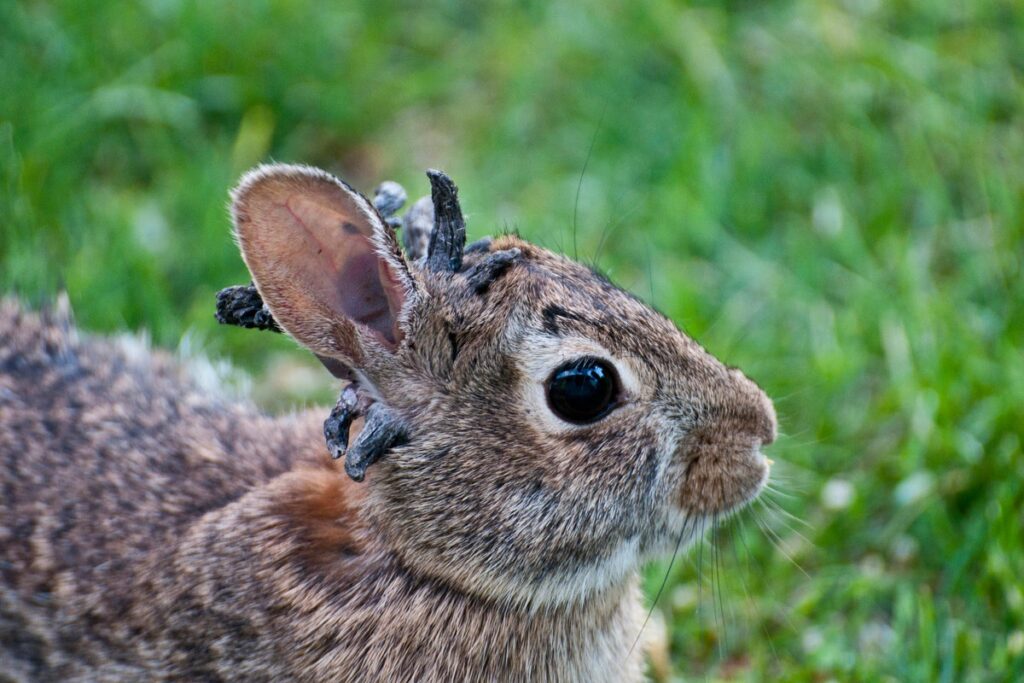August 14, 2025
2 min read
Here’s Why Rabbits Are Sprouting Tentacle Horns
Rabbits spotted with hornlike growths on their face in northern Colorado are doing better than they look
This eastern cottontail rabbit has growths protruding from its head because it is infected with a papilloma virus.
Education Images/Universal Images Group via Getty Images
Rabbits in northern Colorado have been spotted with bizarre, somewhat grisly horns on their face. But wildlife officials say the bunnies are likely ultimately going to be okay.
They’re also not a danger to others—at least, not to nonrabbits. The tentacle-faced bunnies are infected with Shope papillomavirus, a member of the same viral family that can cause warts in humans. Shope papillomavirus is known to affect only rabbits and hares, not humans or other animals, says Kara Van Hoose, a spokesperson for Colorado Parks & Wildlife (CPW). For most rabbits, it’s also a harmless infection.
Infected animals “are able to clear it from their system on their own,” Van Hoose says. Once the virus is gone, the growths, which are made of the same keratin found in hair and nails, eventually fall off. In a minority of cases, the infection can induce squamous cell cancer. The infection can also cause problems if the associated growths pop up near the eyes or mouth, where they might interfere with foraging and eating, Van Hoose says.
On supporting science journalism
If you’re enjoying this article, consider supporting our award-winning journalism by subscribing. By purchasing a subscription you are helping to ensure the future of impactful stories about the discoveries and ideas shaping our world today.
It’s not clear whether there are actually more rabbits than usual infected with Shope papillomavirus in northern Colorado this summer, Van Hoose says. CPW had not received any reports of horned-faced rabbits before a local news story published on August 8 drew attention to sightings in Fort Collins, Colo. Since then multiple people have called the agency, Van Hoose says, but it’s hard to tell how many infected rabbits there really are.
“It’s also difficult to say, if we get 10 reports, if it’s 10 different rabbits or if it’s two rabbits that maybe we’re seeing five different times,” she says.
The growths themselves are not infectious. The virus spreads through bites from mosquitoes, ticks and fleas, so it tends to peak in summer and fade away in the colder months.
The discoverer and namesake of the virus, virologist Richard Shope, first identified the pathogen in 1933 in the U.S. Midwest. Shope also was the first to identify the influenza A virus and was among the first to pinpoint that particular flu pathogen as the culprit of the deadly 1918 pandemic. His work on rabbit papillomavirus formed the basis of understanding human papillomavirus (HPV) strains, some of which can cause cancer. This line of research ultimately led to the development of the HPV vaccine, which dramatically reduces the risk of cervical and other cancers linked to HPV.
Though the horned rabbits aren’t a danger to humans or pets, Van Hoose advises people to keep their distance from the creatures, as they should with any wild animal, because rabbits can pass along other pathogens. “Once you realize these [growths] probably aren’t harmful to rabbits, you can kind of appreciate the science at work,” she says.

